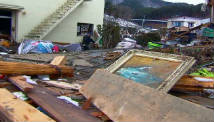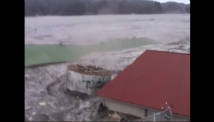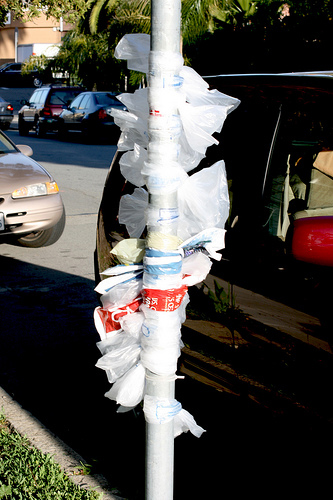
debunkery
By Annalee Newitz
May 21, 2012 9:05 AM
62,75589

Lies You’ve Been Told About the Pacific Garbage Patch
You've probably heard of the "Pacific garbage patch," also called the "trash vortex." It's a region of the North Pacific ocean where the northern jet stream and the southern trade winds, moving opposite directions, create a vast, gently circling region of water called the North Pacific Gyre — and at its center, there are tons of plastic garbage. You may even have seen this picture of the garbage patch, above — right? Wrong.
That image, widely mislabeled as a shot of the Pacific garbage patch, is actually from Manila harbor. And it's just one of many misconceptions the public has about what's really happening to plastics in the ocean. We talked with Scripps Institution marine biologist Miriam Goldstein, who has just completed a study of how plastic is changing the ecosystem in the North Pacific Gyre, about myths and realities of the Pacific garbage patch.
Full size
"That picture of the guy in the canoe has been following me around my whole career!" Goldstein laughed when I brought it up. "I think it's an example of media telephone, where somebody wanted something dramatic to illustrate their story — and then through the magic of the internet, the picture got mislabeled." Goldstein has gone on several research trips to the garbage patch, 1,000 miles off the coast of California, and has even swum in it. "We have never seen anything like that picture," she asserted. "I've never seen it personally, and we've never seen it on satellite."
MYTH: There is a giant island of solid garbage floating in the Pacific.
FACT: There are millions of small and microscopic pieces of plastic, about .4 pieces per cubic meter, floating over a roughly 5000 square km area of the Pacific. This amount has increased significantly over the past 40 years.
In reality, Goldstein said, most pieces of garbage in the Pacific are "about the size of your pinkie fingernail." Though she and her team have found some larger pieces of plastic, like buoys and tires, most are microscopic. What's alarming about them isn't their size, but the sheer amount of plastic. To figure out how much there really is, she and her team have trawled the surface of the ocean in random locations over a 1700 square mile region in the gyre. Once a day, they drag a very fine, specialized net behind the boat. On one such sampling trip, she and her team found plastic pieces in 117 out of 119 random samples. On another, they found plastic in all 28 samples they took.
This is a video of Goldstein in 2010, talking about some of the group's earlier research trips to collect samples from the surface of the ocean in the North Pacific Gyre.
Since the 1970s, scientists have been using the same sampling methods — and the same kinds of trawling nets, invented by oceanographer Lanna Cheng — to measure the amount of plastic in the ocean. So Goldstein and her colleagues are able to make historical comparisons, and measure increases in plastic density. In a recent paper, they write, "Microplastic debris in the North Pacific increased by two orders of magnitude between 1972–1987 and 1999–2010 in both numerical and mass concentrations."

MYTH: All this plastic is killing animals.
FACT: Some animals are being harmed, but others are thriving. Here's why that could be a problem.
Nobody who studies ocean ecosystems would ever argue that this plastic isn't harmful. But many documentaries and articles about the garbage patch make it seem as if the main problem is that the garbage is killing animals. Birds and fish mistake the plastic for food, eat it, and then slowly starve to death. Goldstein points out that there is clear evidence that both birds and fish are eating the plastic, but it's very hard to draw conclusions about whether eating it is killing them. Generally, scientists are only able to examine the stomachs of animals who are already dead.
"Some studies of albatrosses show plastic correlating with poor nutrition — and you do see a lot of dead chicks with their stomachs absolutely stuffed with plastic," Goldstein explained. The problem is that we don't know whether there are also birds who eat the plastic and survive. "We're not going to go around killing baby albatrosses to examine their stomach contents," she added.
This is an even more difficult issue when it comes to fish, since she and many other researchers have found living fish with plastic in their stomachs. It's not clear whether these fish are suffering malnutrition, or are unharmed by eating plastic because they can just pass it out in their excrement. Fish digestive systems are a lot different from those of birds, so it's possible that what's harmful to the albatrosses isn't affecting the fish as much.

And finally, there is a class of creatures who are actually thriving as a result of the plastic influx. These are water skater insects, small crabs, barnacles, and invertebrates called bryozoans, who live on hard surfaces in the water. Some of them, like the barnacles and bryozoans, can do a lot of damage to ship hulls and have caused harm in other ecosystems they've invaded. Usually, these creatures lead a hardscrabble life, barely making it in the deep ocean where hard surfaces are limited to, as Goldstein put it, "the odd floating tree trunk, rare shells, feathers, or pieces of pumice." But now, with all the plastic floating around, these once-rare creatures are enjoying a boom time.
In her recent paper, Goldstein and her colleagues offer persuasive evidence that water skaters are laying their eggs on pieces of plastic in much greater numbers than ever before. Does this mean a glut of water skaters? Not necessarily. Their eggs are large and yellow, which means they stand out in a world of clear blue water. Possibly what's happening is that all these eggs are easy prey for fish and crabs who eat them. No matter what's happening to these eggs, we're going to see an imbalance in this ecosystem, where suddenly a lot more water skaters or crabs are competing with the locals for more food.

MYTH: The plastisphere is killing the ocean.
FACT: The plastisphere is an ecosystem out of balance.
The "plastisphere" is a term coined by marine biologist Erik Zettler to describe the creatures — like water skaters — who thrive in an environment with hard surfaces in the water. They are similar to creatures who cling to piers or the hulls of ships. Before human-made hard surfaces were everywhere, they would have lived on rocks or flotsam. The problem with the plastisphere is that it's radically changing the balance of a sea ecosystem that was once mostly just open ocean creatures.
"One thing that people worry about is that hard surfaces can transport invasive species," Goldstein said. "Some animals are good at hitching a ride and they can be destructive. By adding big chunks of plastic these species can move around better, and could be introduced to places like the Northwest Pacific Islands, where there are some of the best coral reefs in the world." In other words, the plastisphere isn't destroying the ocean ecosystem — the creatures who ride on the plastic are. We're witnessing an ecosystem that is slowly falling off balance.
For now, the open ocean is still mostly inhabited by lantern fish. "There's one lantern fish for every cubic meter of ocean," Goldstein explained, noting that these fish are probably more common than the pieces of plastic her team has sampled. But if trends continue, we're going to see more plastic than fish. And with that plastic will come more invasive species, more water skaters, and more creatures to eat the water skaters' eggs. The danger is that this could alter the open ocean forever — and destroy all the native life there that has kept the oceans healthy for thousands of years.
Read Goldstein, et. al.'s paper about water skaters in Biology Letters.





 Reply With Quote
Reply With Quote Expeditions to ocean gyres sometimes encounter 'ghost nets' - discarded fishing equipment that can tangle into a hazard for marine organisms.
Expeditions to ocean gyres sometimes encounter 'ghost nets' - discarded fishing equipment that can tangle into a hazard for marine organisms.  First wave of tsunami debris hits U.S.
First wave of tsunami debris hits U.S.  Quake, tsunami debris threaten coastlines
Quake, tsunami debris threaten coastlines 


 The mess of plastic in the Pacific Ocean known to many as the
The mess of plastic in the Pacific Ocean known to many as the 



 " width="1102">
" width="1102"> 


Bookmarks